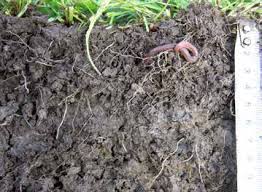Meadow - grassland
 In addition to livestock farming, agriculture and horticulture, there is also forestry. And even (permanent) grassland management. But there is very little information on this. In industrial agriculture, it is also quite simple. Spray everything down and plow it. Buy a grass mixture adapted to sheep, cattle or horses and sow it.
In addition to livestock farming, agriculture and horticulture, there is also forestry. And even (permanent) grassland management. But there is very little information on this. In industrial agriculture, it is also quite simple. Spray everything down and plow it. Buy a grass mixture adapted to sheep, cattle or horses and sow it.
Seems the ley is still in decent shape then the soil tillage drops, and new grass seed can be added by 'overseeding'.
Worldwide consists 70% of Agricultural land of grassland. It’s the most important cattle feed. Besides Hill grazing there is not plowed permanent meadow and short term leys with very little variation (but high stocking rates). Not grazed grassland will naturally become (rough, bushes) forest again.
In winter the animals are kept indoors, otherwise they devour the grass too short and their steps destroy the ground. Therefore, sufficient hayfield is needed. The farmer works himself drowsy and brings opposed to natural attrition, the feed to the animals. And we need feeding extra to offer sufficiently diverse nutrients.
What goes wrong? Why should we work so hard to invest and nurture cattle while they actually could always take care of themselves?
Especially our short-sightedness, and the search for quick profits are to blame.
In this article I will not talk about the in function of speed and a lot of milk or meat selected breeds, by quasi inbreeding and antibiotics becoming vulnerable for diseases, or the disproportion between the number of animals and space. But only on the turf.
Grass is a simple and stubborn weed that can be found almost everywhere.
Vegetations in which grasses predominate are called grasslands.
Grass lives in symbiosis with grazing animals, they cannot survive without each other. By grazing young shoots get light and grow, otherwise this form of vegetative or asexual reproduction stifled.
And grazers will have in turn a symbiosis with bacteria in their intestinal tract, without which they can difficult or impossibly digest grass.
Modern meadow is an agricultural product, obtained by sowing and harvesting. Grass is almost grown as corn on bare soil, sprayed with selective herbicides and fed with fertilizer.
I recently saw a picture of a field that has been freshly plowed. In addition, the same land that was torn a few decades ago. The difference?
Gulls. And other birds. You no longer see them. Because there is no food to be found. The soil is dead. Because of all the crap that we use. And by constantly exposing the bare earth to the sun.
In a shovelful of earth are tens of thousands of life forms. From small to large, there are seven groups of soil organisms: bacteria, fungi, protozoa, nematodes, mites and springtails, potworms (Enchytraeidae) and earthworms. There are predators that eat other types in the soil, but also herbivores, omnivores, mold and bacteria eaters.
Duckweed (Lemna, family Lemnaceae or, nowadays, Araceae) is a tiny plant that propagates and grows quickly, floating on slow running or stagnant water. Duckweed exist in 4 plant families: lemna, spirodela, wolffia and wolffiella. Lemna has only one root, which distinguishes it from Spirodela species. They are only 1-10 mm and usually have only one leaf and no stem. They are eaten by fish, rats, ducks, carp, chickens (including cattle).
This rapid growth champion doubles its biomass in 16 hours, it doubles every two to three days (ideally every 30 hours), goes from 1 m² to 1000 m² in one week and can be harvested daily.
It delivers seven times as much protein per hectare (content 15-45%) as soy, with a dry matter content of 5-10% or 10-30 tonnes per hectare per year.
The ideal water temperature for duckweed is 26 ° C with a day length of 13 hours. If the density is too high (> 80 g DG / m²), duckweed provides competition for light and nutrients. If the density is too low (<24 g DG / m²), algae compete with duckweed for nutrients.
It is highly digestible (protein 80%) and contains many different interesting essential amino acids (lysine and threonine but less methionine), up to 5% fat (with the omega-3 fatty acid J-linolenic acid) and fibers. It is theoretically similar to animal protein such as in meat and milk.
It (unfortunately) not only concentrates phosphorus but also heavy metals from the water. Copper, cadmium and arsenic then make it unsuitable as (animal) food.
The world's smallest flowering plant is the watermeal, or Wolffia globosa. A variety of Wolffia Globosa even offers all nine essential amino acids, polyphenols, iron and zinc. In addition to minerals, duckweed also contains dietary fiber, antioxidants and beta-carotenes and, according to 2 studies, possibly also vitamin B12. Israeli researchers created a new species, the Mankai. Will this be the first plant to produce significant amounts of B12?
Water lentils are not (yet) allowed for human consumption (in Europe). The Dutch Association for Veganism advises members to use a vitamin B12 supplement.
Dutch researchers found in January 2020 that an excessive amount of vitamin B12 in the blood leads to earlier death, but (still) without a clear cause-effect relationship.
